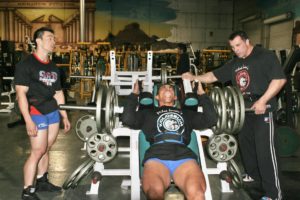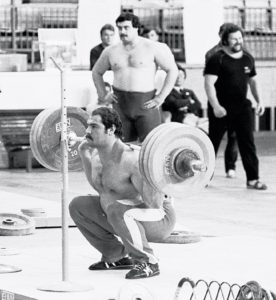
Ensure your training success with a motivated workout team
Strength Sensei CP
Publication Date: 2001
I’m often asked if it’s better to train alone or with a training partner – the answer is neither! To create the most anabolic environment for increasing strength and packing on muscle, you should have at least two training partners. Here are seven reasons why:
- No one is up for every workout.Group dynamics will always boost individual training drive, especially when bets and competitions are involved. Typically one training partner will be up, one will be down, and one will fall somewhere in the middle. The leader of the day will help keep up the average intensity.
- A group of three is usually optimal.Weight training is not a team sport, so three training partners is usually ideal. Let’s say the group is training dips and chins for relative strength. Here is how their sets could progress:
— The weakest person goes first, and each keeps adding weight until the last one goes; then, they start over. For example, Wimpy Albert goes first, OK Bob goes second, Buff Master Carl goes last, and then they repeat.
Here is how that same group would progress when training for functional hypertrophy, which involves a shorter rest interval:
— Albert starts on chins, Bob starts on dips, and Carl waits his turn. This rotation keeps the rest interval optimal.
- There is always someone better than the others in a specific lift.Seldom is one training partner the best in every lift, and this difference brings about healthy competition. Healthy competition brings out the best in people.
- Changing the weights and cleaning is a cinch.Lifting in a small group is more efficient than training solo. When lifting bumpers off the end of a barbell used for deadlifts, one lifter can lift one end of the bar off the floor while another person easily pulls the weight off the bar.
- Experienced lifters won’t need stopwatches.Training in groups moves the workout along at an optimal pace. That is, the length of the pause between lifters performing their work sets becomes engrained in their internal clocks.
- Small group training is safer.Weightlifters often squat on the lifting platform, using a bar with bumper plates. If they miss a lift, they dump the weight backward, which takes some skill when using especially heavy weights. In most commercial gyms, it’s best to have two lifters spotting a squat. If you have three training partners, two can spot the lift while the other can coach the lifter to push harder or giving coaching tips.
- Promotes effective use of training logs.If only one spotter is needed, one person can spot while the other updates their training log, when the numbers and training experiences are still fresh. If you wait until the end of a workout to complete a training log, you may have forgotten exactly what you did or what needs to be changed. Tommy Kono is a 2x Olympic gold medal winner who broke world records in four weight classes. He said, “The palest ink is better than the best of memories.”
 Experienced weightlifters will often squat without a spotter, simply dropping the weight on the platform. (Bruce Klemens photo)
Experienced weightlifters will often squat without a spotter, simply dropping the weight on the platform. (Bruce Klemens photo)
The major hurdle with small group training comes when group synergy is at odds with individual training goals. If one member wants to be a bodybuilder, one wants to be an offensive lineman, and one wants to be a powerlifter, the program design will center on making compromises. Compromise, in this case, is not a good thing.
That’s my sales pitch for recruiting multiple training partners. Bottom line: If you can find two other colleagues who share your training goals, you’ll experience an outstanding shortcut to success!
